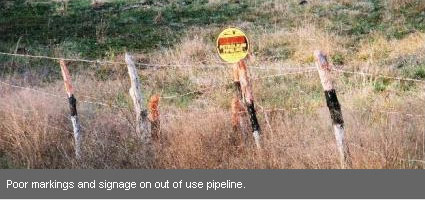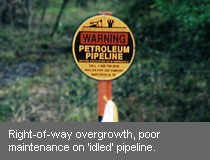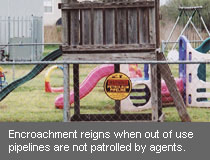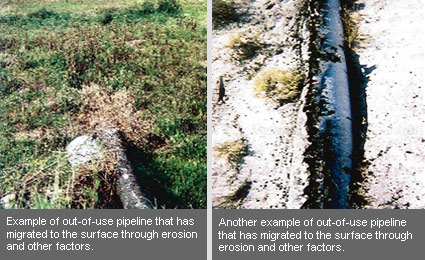Pipeline Equities
PO Box 571977
Houston, Texas 77257
Phone: 713-623-0690
Pipeline Recovery
excavation & removal
Damage Assessment
of easements
Pipeline Appraisal
pipeline property valuation
Pipeline Equities
PO Box 571977
Houston, Texas 77257
Phone: 713-623-0690
excavation & removal
of easements
pipeline property valuation
I recently received a call from a landowner on whose land a pipeline was buried. On this particular tract of land in Central Texas, the pipeline in question was only 300 feet in length. The right-of-way, or easement, was no longer mowed or otherwise maintained. Signs along the right-of-way were down or in disarray.

The landowner had done some detective work and found through the Texas Railroad Commission (TRRC) Pipeline Safety Office that the line had in fact been abandoned and in the past had been used as part of a 60-mile and longer crude line for a major pipeline company. He persisted and made contact with someone at the pipeline company who acknowledged ownership of the line even though it was deemed abandoned by state regulatory authorities. The landowner explained that he wanted to ascertain the idleness or abandonment of the pipeline because he had plans to build on that parcel, and the pipeline presence would interfere somewhat with, or at least complicate, the building process. The pipeline company indicated they would look into the matter. An environmental subcontractor then called the landowner with the pipeline company’s solution. The subcontractor had been instructed by the pipeline company to remove the pipeline if the landowner was willing to pay for the $51,000 expense of removal. The landowner then asked me what I would charge to do the same job and I told him $1,000 to $1,500 as it looked to be about a day’s worth of work.
Unfortunately, the landowner was not able to hire our company because the abandoned pipeline was still the property of the pipeline company. The issue was ownership. The pipeline company claimed ownership, but did not assume responsibility for maintenance or removal of the pipeline. For some reason, the pipeline company determined that the landowner ought to be responsible for removal expenses and that a qualified environmental company of their choosing ought to be used for the removal. Why was this? Was there an unknown environmental hazard?
A dictionary definition for abandonment means to “give up entirely.” Defined in terms of federal regulations, abandonment means “permanently removed from service.” In federal pipeline safety jargon, an abandoned pipeline is a pipeline that is “physically separated from its source of gas and is no longer maintained,” or in another federal agency glossary, “no longer connected to the system and is no longer maintained. The pipeline can be abandoned in place, by removal, or sold.” In still another set of federal guidelines, abandoned property means “a property that, because of its general disrepair or lack of activity, a reasonable person could believe that there is intent on the part of the current owners to surrender their rights to the property.” All of these definitions apply to gas and hazardous liquid pipelines that are interstate and fall under federal jurisdiction.

However, there are no guidelines for abandoned crude oil pipelines that fall under the jurisdiction of the Interstate Commerce Commission, and, presumably, the agencies that have succeeded to that federal agency’s role since it was abolished in 1995, as common carriers.
At the state level, there are no abandonment guidelines or definitions for intrastate gas, liquids, or oil pipelines, and there are no abandonment guidelines or definitions for intrastate oil or gas gathering systems. Any mention of abandonment of pipeline procedures follows federal guidelines of disconnecting from active gas service and purging of any hazardous substance.
Individual state guidelines generally follow federal guidelines if they have any guidelines at all. (Texas is one of the few that addresses the issue whatsoever.) However, the federal government has no guidelines, criteria, or regulations to determine ownership of abandoned pipelines.
The pipeline in Central Texas was an oil pipeline, so if it were abandoned responsibly, it would have been purged of any hazardous substance as suggested, but not necessarily mandated, by Texas guidelines. Again, why would an environmental company need to be involved in the take up process? Are there other issues that the pipeline owner did not disclose?
On further investigation, the landowner in Texas found other areas where the same line had been cut and removed, and the pipeline company continued to own the easement, but obviously did not feel a responsibility to maintain the right-of-way or to “give up entirely” the right-of-way easement to the landowner. The Texas landowner now has a pipeline to nowhere.

Out of use, uneconomic and abandoned pipelines are not on the priority list of any business development or asset manager. They simply don’t provide substantial profit outlook, and they are generally identified as liabilities. That said, most gatekeepers of this sector in a pipeline company simply sweep the issue aside and do not address it. The reasons for this include:
The search for abandoned pipelines often begins when a landowner or other interested party notes that a pipeline easement is not being maintained and starts asking questions. Very few states keep track of abandoned pipelines. The Federal Energy Regulatory Commission (FERC) publishes and approves guidelines for abandoning pipelines, but does not continue oversight after the pipeline has been abandoned and abandonment criteria have been met.
In searching for abandoned pipelines to purchase or otherwise obtain, the firm, Pipeline Equities, will check its own database and old pipeline maps from the archives of defunct pipeline companies as well as any geologic and land owner maps showing oil and gas wells and leases.
It is necessary to know as much information as possible about an abandoned pipeline because most pipeline companies will say any out of use line is only temporarily idled, even if has been out of use for 20 years. I have asked about the presence or availability of abandoned lines at several companies, and the answer is almost always, “No, we don’t have any.” Even when I have evidence of a company owning 3,000 miles of abandoned lines, I have received the same response. There seems to be a reluctance to talk about abandoned pipelines, even if you can find someone with any knowledge about them. I have found that in major companies that utilize pipelines, there are just not that many policies for dealing with these issues.
One company I was dealing with was prompted to actually order an inventory to determine what pipelines they really had. When I made an offer to buy the abandoned and out of use pipelines, the company replied that they did not have a policy regarding the disposition of these properties. They did hire interns and produced an inventory of the idled or abandoned lines. Once they found out what their inventory consisted of, they had to determine what their policy for these idled pipelines would be. The policy determination, in this case, was the same as it had always been and is with most companies – leave them alone, and do nothing. This is the existing policy for many major pipeline companies.
Why? There are no advocates within the structure of most companies. Business development officers don’t want to bother with what might be determined to be liabilities. Operations does not have the time or the inclination. Environmental does not have the authority, and–by now–right-of-way departments are outsourced. No one really cares. Abandoned or idled pipelines are out of sight and out of mind.
An interesting aspect of this and other cases is the “fixture” nature of the pipeline. According to attorneys, if the pipeline company has given up the easement via formal recording back to the landowner, then the pipeline company would also be “giving up entirely” the ownership of the pipeline which has become a fixture to the easement. Attorneys say legal opinions have stated that pipelines and appurtenances to pipelines are part of the package of, or fixtures to, the easements they are on. Somewhat like a toilet, sink, and bathtub belong to a bathroom. The fixtures stay, and if the easement reverts to a landowner, then the pipeline reverts as well.
More often than not, this transfer is never done on a formal basis and the ownership remains in the name of the original grantor (the pipeline company) until someone takes the initiative to clear it up. It would probably take a court order in each (county) jurisdiction.
Ultimately, ownership is determined, first, by contract. That is to say that the original right-of-way agreement or contract is the law. Attorneys say other legal developments have determined that abandonment by giving up entirely can be accomplished if it can be determined that “intent to abandon” is present or “cessation of usage” is evident. Presence of either of these conditions may change ownership of the pipeline and easement despite the language of the original contract. Again, this change in ownership might require a court order in each jurisdiction.
These agreements or contracts between grantor (landowner) and grantee (pipeline owner) generally have the following four parts, but agreements over 50 years old only contain the first three parts:
A pipeline right-of-way is really no different than any other kind of easement, and therein lies some interesting comparisons and–in some cases precedent–for extinguishing or canceling agreements, even ones that were written to have a perpetual term.
Why the language of abandonment in the regulations? The simple explanation: the pipeline company is no longer responsible for taking care of the pipeline according to regulations as if it were an active viable pipeline. That means pipeline companies no longer have to worry about regulatory fly-bys to verify if the right-of-way can be seen from the air.

The Texas Railroad Commission is responsible for fly-bys in Texas and ceases fly-by activity when a pipeline is designated as abandoned. Once a pipeline is designated as abandoned, pipeline owners and operators no longer incur the expense of maintaining easements with expensive mowing and caretaking. And, they no longer have to paint posts and put up new signs to mark the pipeline. All of these responsibilities are expensive and time consuming.
Another huge bonus for abandoning a pipeline is reduction of taxes or total elimination of ad valorem, school, county and other jurisdictional levies. Generally speaking, taxes are almost non existent for abandoned pipelines. But still, if a landowner wants to claim the pipeline on his or her property, the pipeline company will likely claim it is their property and explain that the pipeline is only “idled” as opposed to a “given up entirely” type of abandonment.
In the case of our friend in Central Texas, he can have the easement returned, but not the pipeline fixture. He must pay the price of a pipeline company approved contractor with environmental supervision standing by in order to make his own land usable. This was not the way it was supposed to be. So, abandonment of pipelines can mean many things to many people.
During the course of allowing an idled, abandoned, or out of service pipeline to deteriorate, other changes occur as a result of the lack of care and maintenance. Easements are allowed to grow up and out. Trees sprout and grass grows. Neighbors and landowners begin encroachment activity and the problems are compounded. When it is evident that a pipeline right-of-way is not being maintained, the signal goes out that no one cares, and encroachment begins. Structures are built, and seemingly squatters’ rights are the rule of the day on ill-maintained rights of way.
The business of some salvage companies is the removal and recycling of out of use pipelines. For the most part, pipeline companies are not interested in the business of recycling as they have determined that there are too many environmental risks to allow shallow pocket pipeline recovery companies the run of a right-of-way. The safest bet is to let it lie rather than take a chance that a pipeline recovery company might uncover some surprises that no one wants to deal with.
The call our company received from the Texas landowner is only one example. We field an average of three calls per week from property owners seeking a way to get rid of a piece of pipeline that is interfering with a construction or excavation project. Other calls involve inquiries about restoring easements that are clouding title.
The following are a number of factors a court or jurisdiction might consider in determining whether an easement or right-of-way (including the buried pipeline) has been canceled, extinguished and thus effectually reverted to the landowner:
The grantee company’s obligation to release an easement containing an idle pipeline upon the request from a landowner will first depend on the specific provisions of the contract or instrument granting the easement. This instrument is almost always the right-of-way agreement. If that contract or instrument does not specify a term or condition for reversion of the easement, then it will depend on whether the landowner can establish that the purpose for which the easement was granted has ceased or that the grantee company can no longer use the easement for its intended purpose.
The reality is that most landowners are not going to go to the expense and time to prove this. The pipeline companies know this and quietly deal with incidents one at a time with special attention given to larger parcel owners along the right-of-way. The idea that a landowner with a quarter-mile section of pipeline on his property is going to file suit against a major pipeline company is unlikely. However, if the landowner is desperate to sell that property or needs to build on the land, he or she will seek a remedy somewhere.
Be warned, pipeline operators: there are too many hungry plaintiff’s lawyers and tree huggers out there. In addition there are many landowners that are weary of warehousing obsolete pipelines for pipeline companies. I should note here that this new Congress and new administration in Washington really do not like us very much. And that is on a federal level. On the state level in Texas, a bill will be introduced in the coming legislative session that will require pipeline companies to get permission from each landowner before abandoning a pipeline on their property. In addition, the companies will have to account for all dormant pipelines that have previously been idled or abandoned. This type of legislation might signal the end to the practice of “in place” abandonment of pipelines.
The central Texas rancher continued in his attempts to have the pipeline company remove the 330 foot pipeline segment from his property. He did get a concession of a price reduction from $51,000 to $37,000 for the take up by the environmental company approved by the pipeline operator. At this point he went to a lawyer who did some research and found that most pipelines of that vintage were coated with a material that contained asbestos. The lawyer found a case regarding an abandoned jet fuel pipeline with asbestos coating near a townsite in Maine. A local court determined that the line did cause contamination under the townsite and possibly was a problem for the local water supply and the health of future generations. The attorney for the Texas rancher noted that the pipeline in question was located over the Edwards Aquifer in Central Texas for a 40-mile stretch. In place abandonment of pipelines is no longer an option.
For case law, Code of Federal Regulation, and other references for this article, send an email request to davidhowell@pipelineequities.com

Fill out the short form below to receive our Pipeline Recovery Manual.
Sign up for our free newsletter to receive your complimentary copy of our Pipeline Recovery Manual that explains our entire process for recovering or salvaging idled or abandoned pipelines.
You will see how we deal with landowners regarding notification and recordings. How to draft a contract of sale with models by: Exxon, Texaco, Koch and others and pictures showing actual work in process.
The manual shows Pipeline Equities job references, right of way releases, agreements and the history and background of Pipeline Equities and managing partner David Howell. These references touch on parts of the six million feet of line removed or handled by the company over the past twenty years.
A line pipe table describing various weights, grades, and pressure ratings of ERW and seamless line pipe is included. This section is an indispensable tool for anyone doing operational word with line pipe.
Also included are extensive glossaries of pipe, pipeline, and right of way terms.

Request a complimentary Pipeline Appraisal Handbook
Fill out this short form and you will be sent a confirmation link to our Newsletter. Once you click the link you will be subscribed to our newsletter and taken to a page where you can download the Pipeline Appraisal Handbook.
This handbook written by David Howell, managing partner of Pipeline Equities is the basic text of any pipeline valuation. All of the essential factors for establishing the value of a pipeline are discussed along with exclusive proprietary formulas and tables essential to a certified appraisal.
Also included are 32 pages of pipe weight and grades tables that cover virtually any situation which might be encountered regarding line pipe requirements. Additionally you’ll find an extensive glossary of pipe, pipeline and right of way terminology is part of the Handbook.
Subjects include: Replacement, Right of Way, Surface Inventory, Throughput, Salvage/Recovery, and comparable sales histories to name a few of the basic factors of pipeline appraisal.
The author recognized a need for a report or “how to” manual for properly appraising pipelines and pipeline right of ways. Currently the work is being done by accounting firms, engineers, and real estate appraisers.
Howell has forty-five years experience in many sectors of the petroleum industry from drilling contractor and oil and gas operator to pipe and supply distribution throughout the world. He has published Tradex Equipment magazine, the Whole World Oil Directory, and the Texas Oil Register.
For the past twenty years, Howell has been almost exclusively engaged in pipeline sales and acquisition, appraisal, removal for salvage, environmental remediation and general pipeline operations.
Howell currently serves on board of the Pipeline Appraisal Institute and is a member of the International Right of Way Association. Howell is a graduate of Texas A&M University – Kingsville and a native of Alice, Texas. He is currently residing in Houston and is the managing partner of Pipeline Equities.